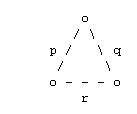Wythoff Symbols and TOCID Symbols
Contents
1. Wythoff Symbols
2. Wythoff Symbols (modified notation)
3. TOCID notation
4. Table of Platonic and Archimedian Solids
5. Table of Uniform Star Polyhedra
6. Blends of Polyhedra
I am indebted to Dr Norman Johnson for
providing this explanation of Wythoff Symbols and TOCID symbols, and
for giving me permission to include
his work here. JM.
1. Wythoff
Symbols
A Schwarz triangle is a spherical, Euclidean, or hyperbolic
triangle that covers S^2, E^2, or H^2 a finite number of times when
repeatedly reflected in its sides. In
Wythoff's construction the vertices of a uniform polyhedron or
tessellation are the kaleidoscopic images (or half the images) of a
suitably chosen point on the boundary or in the interior
of some Schwarz triangle. A Schwarz triangle (p q r), with angles pi/p,
pi/q, pi/r, may be represented by the
Coxeter diagram below:

The polyhedron or tessellation is represented by its Wythoff
diagram, in which one or more nodes of the Coxeter diagram are
ringed. For a snub figure all three nodes are ringed and then the nodes
are removed.
In their 1954 monograph "Uniform Polyhedra", Coxeter, Longuet-Higgins
and Miller employed Wythoff's construction systematically to obtain all
the uniform polyhedra that can be realized in Euclidean space, as well
as a number of uniform tessellations of the Euclidean plane. In doing
so they identified each polyhedron or tessellation by a Wythoff symbol
based on the associated Schwarz triangle (p q r), indicating which
nodes in the Wythoff diagram are ringed or that the diagram has three
nodeless rings. Their symbols generally take one of the forms

Certain polyhedra or tessellations are "blends" of two other figures
and have symbols with four numbers.
The four Wythoff symbols above correspond to the Wythoff diagrams

2. Wythoff
Symbols (modified notation)
There is also an improved version of the Wythoff symbol that is
somewhat more intuitive and that has several other advantages. In the
modified notation, the corresponding Wythoff symbols are

In general, the face polygons of the respective uniform polyhedra are
{p}'s and {q}'s; {p}'s, {q}'s, and {2r}'s; {2p}'s, {2q}'s, and {2r}'s;
and {p}'s, {q}'s, and {r}'s surrounded by triangles. However, a "digon"
{2} is merely an edge.
Two other possible Wythoff diagrams are

with p even in the first case and q even in the second. The respective
Wythoff symbols are

The face polygons of the first figure are {p/2}'s and {q}'s. Those of
the second are {p}'s, {q/2}'s, and triangles. Again, any {2}'s may be
ignored.
Polyhedra or tessellations (usually nonorientable) obtained as blends
of other figures having the same vertices and edges and some of the
same faces include the "versi-quasi-regular" figures

The four numbers in the symbol indicate that the figure is derived from
>two< Schwarz triangles, (r s p/2) and (r s q/2). The face
polygons are {2r}'s and {2s}'s.
The unique uniform polyhedron with eight faces at a vertex ("Miller's
monster") has the symbol
| 3/2 5/3 3 5/2 = {3/2 5/3 3 5/2}.
Its face polygons are {3}'s, {5/2}'s, and squares, with the faces of
each type occurring in coplanar pairs.
Among the advantages of the modified notation are that it is easy to
see what kind of faces a figure has and to recognize figures that are
closely related or that belong to the same class. Moreover, unlike the
original notation, the modified Wythoff symbols are readily extended to
uniform polychora or 3-honeycombs obtained by Wythoff's construction
from Goursat tetrahedra.
3. TOCID Notation
Wythoff symbols are natural companions to the TOCID notation
whereby each Platonic or Archimedean solid is denoted by a symbol based
on its Keplerian name. From the
octahedron O = {2 3}(4) or the
cube C = {2 4}(3) we can derive the quasi-regular
cuboctahedron CO = {3 4}(2), and from the icosahedron I = {2 3}(5) or the
dodecahedron D = {2 5}(3) we can derive the
analogous icosidodecahedron ID = {3 5}(2). The
"tetratetrahedron" TT = {3 3}(2) is the same as the
octahedron. Other uniform solids can be obtained
from the regular and quasi-regular solids by means of one of the
operations of "rectification," "simiation," or "tomiation," denoted by
prefixing one of the lower-case letters 'r', 's', or 't'. In keeping
with Kepler's terminology, 'r', 's', and 't' can also be rendered as
"rhomb(i)-," "snub," and "truncated."
The TOCID notation can be extended to the Kepler-Poinsot polyhedra and
other uniform star polyhedra, as well as to prisms, antiprisms, and
crossed antiprisms. In the symbol for a quasi-quasi-regular or
versi-quasi-regular polyhedron, one or two lower-case letters indicate
the kind and number of faces such a polyhedron has in addition to (or
instead of) the faces found in the associated quasi-regular polyhedron.
Originally, no distinction was made between octagons and octagrams or
between decagons and decagrams. But a slight modification of the
notation makes it possible to specify each type of face uniquely.
The letters 'a', 'b', 'c', 'd', 'e', 'i', and 'r' may be regarded as
nominal abbreviations for certain descriptors, corresponding to a given
number of faces, as follows:
a 4 hexagons
b 6 octagons
c 6 octagrams
d 12 decagons
e 12 decagrams
i 20 hexagons
r N squares (N=6, 12 or 30)
Below I list all the uniform polyhedra, convex or starry, with their
TOCID symbols, Wythoff symbols, and names. In a few cases polyhedra can
be derived in more than one way and so have alternative symbols and
names. Such duplications are indicated by giving the canonical TOCID
symbol in parentheses after the alternative name.
4. The
Platonic and
Archimedean Solids
5. Uniform
Star Polyhedra
6. Blends of polyhedra
In the list below I have grouped sets of three polyhedra with the same
vertices and edges, each being a "blend" of the other two.



